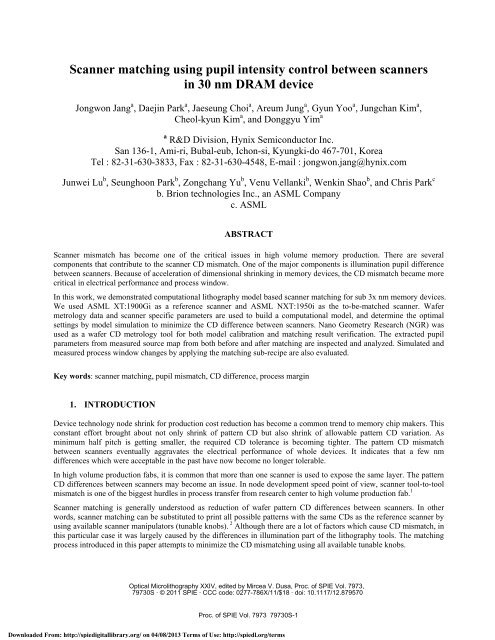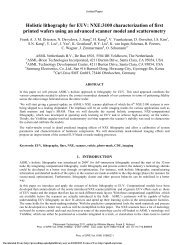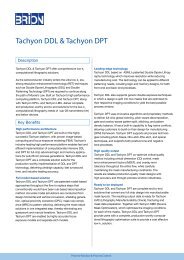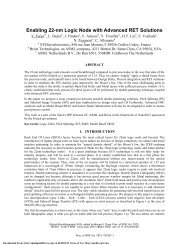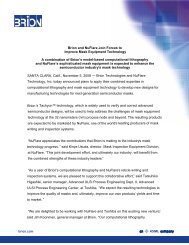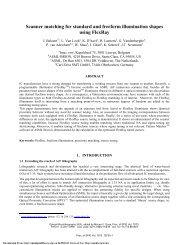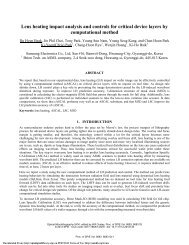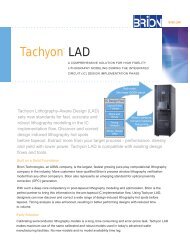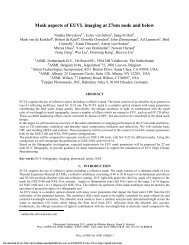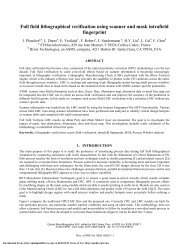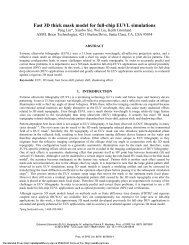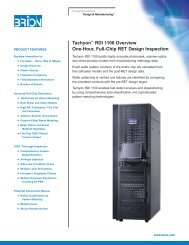Scanner matching using pupil intensity control between scanners in ...
Scanner matching using pupil intensity control between scanners in ...
Scanner matching using pupil intensity control between scanners in ...
- No tags were found...
You also want an ePaper? Increase the reach of your titles
YUMPU automatically turns print PDFs into web optimized ePapers that Google loves.
<strong>Scanner</strong> <strong>match<strong>in</strong>g</strong> <strong>us<strong>in</strong>g</strong> <strong>pupil</strong> <strong><strong>in</strong>tensity</strong> <strong>control</strong> <strong>between</strong> <strong>scanners</strong><br />
<strong>in</strong> 30 nm DRAM device<br />
Jongwon Jang a , Daej<strong>in</strong> Park a , Jaeseung Choi a , Areum Jung a , Gyun Yoo a , Jungchan Kim a ,<br />
Cheol-kyun Kim a , and Donggyu Yim a<br />
a R&D Division, Hynix Semiconductor Inc.<br />
San 136-1, Ami-ri, Bubal-eub, Ichon-si, Kyungki-do 467-701, Korea<br />
Tel : 82-31-630-3833, Fax : 82-31-630-4548, E-mail : jongwon.jang@hynix.com<br />
Junwei Lu b , Seunghoon Park b , Zongchang Yu b , Venu Vellanki b , Wenk<strong>in</strong> Shao b , and Chris Park c<br />
b. Brion technologies Inc., an ASML Company<br />
c. ASML<br />
ABSTRACT<br />
<strong>Scanner</strong> mismatch has become one of the critical issues <strong>in</strong> high volume memory production. There are several<br />
components that contribute to the scanner CD mismatch. One of the major components is illum<strong>in</strong>ation <strong>pupil</strong> difference<br />
<strong>between</strong> <strong>scanners</strong>. Because of acceleration of dimensional shr<strong>in</strong>k<strong>in</strong>g <strong>in</strong> memory devices, the CD mismatch became more<br />
critical <strong>in</strong> electrical performance and process w<strong>in</strong>dow.<br />
In this work, we demonstrated computational lithography model based scanner <strong>match<strong>in</strong>g</strong> for sub 3x nm memory devices.<br />
We used ASML XT:1900Gi as a reference scanner and ASML NXT:1950i as the to-be-matched scanner. Wafer<br />
metrology data and scanner specific parameters are used to build a computational model, and determ<strong>in</strong>e the optimal<br />
sett<strong>in</strong>gs by model simulation to m<strong>in</strong>imize the CD difference <strong>between</strong> <strong>scanners</strong>. Nano Geometry Research (NGR) was<br />
used as a wafer CD metrology tool for both model calibration and <strong>match<strong>in</strong>g</strong> result verification. The extracted <strong>pupil</strong><br />
parameters from measured source map from both before and after <strong>match<strong>in</strong>g</strong> are <strong>in</strong>spected and analyzed. Simulated and<br />
measured process w<strong>in</strong>dow changes by apply<strong>in</strong>g the <strong>match<strong>in</strong>g</strong> sub-recipe are also evaluated.<br />
Key words: scanner <strong>match<strong>in</strong>g</strong>, <strong>pupil</strong> mismatch, CD difference, process marg<strong>in</strong><br />
1. INTRODUCTION<br />
Device technology node shr<strong>in</strong>k for production cost reduction has become a common trend to memory chip makers. This<br />
constant effort brought about not only shr<strong>in</strong>k of pattern CD but also shr<strong>in</strong>k of allowable pattern CD variation. As<br />
m<strong>in</strong>imum half pitch is gett<strong>in</strong>g smaller, the required CD tolerance is becom<strong>in</strong>g tighter. The pattern CD mismatch<br />
<strong>between</strong> <strong>scanners</strong> eventually aggravates the electrical performance of whole devices. It <strong>in</strong>dicates that a few nm<br />
differences which were acceptable <strong>in</strong> the past have now become no longer tolerable.<br />
In high volume production fabs, it is common that more than one scanner is used to expose the same layer. The pattern<br />
CD differences <strong>between</strong> <strong>scanners</strong> may become an issue. In node development speed po<strong>in</strong>t of view, scanner tool-to-tool<br />
mismatch is one of the biggest hurdles <strong>in</strong> process transfer from research center to high volume production fab. 1<br />
<strong>Scanner</strong> <strong>match<strong>in</strong>g</strong> is generally understood as reduction of wafer pattern CD differences <strong>between</strong> <strong>scanners</strong>. In other<br />
words, scanner <strong>match<strong>in</strong>g</strong> can be substituted to pr<strong>in</strong>t all possible patterns with the same CDs as the reference scanner by<br />
<strong>us<strong>in</strong>g</strong> available scanner manipulators (tunable knobs). 2 Although there are a lot of factors which cause CD mismatch, <strong>in</strong><br />
this particular case it was largely caused by the differences <strong>in</strong> illum<strong>in</strong>ation part of the lithography tools. The <strong>match<strong>in</strong>g</strong><br />
process <strong>in</strong>troduced <strong>in</strong> this paper attempts to m<strong>in</strong>imize the CD mis<strong>match<strong>in</strong>g</strong> <strong>us<strong>in</strong>g</strong> all available tunable knobs.<br />
Optical Microlithography XXIV, edited by Mircea V. Dusa, Proc. of SPIE Vol. 7973,<br />
79730S · © 2011 SPIE · CCC code: 0277-786X/11/$18 · doi: 10.1117/12.879570<br />
Proc. of SPIE Vol. 7973 79730S-1<br />
Downloaded From: http://spiedigitallibrary.org/ on 04/08/2013 Terms of Use: http://spiedl.org/terms
2. BASIC THEORY FOR SCANNER MATCHING<br />
2.1 Model-based scanner <strong>match<strong>in</strong>g</strong> methodology<br />
The target scanner which shows the desired pattern CDs and process marg<strong>in</strong> is called the reference scanner (ASML XT<br />
1900Gi), and the scanner which shows different CD trend from the reference scanner is called the TBM (to-be-matched)<br />
scanner (ASML NXT 1950i). ASML’s Pattern Matcher FullChip (PMFC) is used as the simulation and optimization<br />
eng<strong>in</strong>e <strong>in</strong> this paper. PMFC uses computational lithography approach <strong>in</strong> layout simulation and scanner tun<strong>in</strong>g. It<br />
optimizes the TBM scanner sett<strong>in</strong>gs <strong>in</strong> order to match the reference scanner on a given set of target patterns. Unlike<br />
traditional scanner <strong>match<strong>in</strong>g</strong> methods which are based entirely on wafer CD measurements, PMFC uses lithographic<br />
simulation together with wafer CD measurements to provide quick and accurate <strong>match<strong>in</strong>g</strong> solution.<br />
Lithographic model is the central element <strong>in</strong> this approach. The <strong>match<strong>in</strong>g</strong> process starts from build<strong>in</strong>g a model that<br />
captures characteristics <strong>in</strong> lithography and resist processes. Tachyon FEM+ TM model<strong>in</strong>g eng<strong>in</strong>e takes scanner optics and<br />
FEM (Focus Exposure Matrix) wafer CD measurements to calibrate OPC quality model. The model not only needs to<br />
have CD prediction ability, but it also needs to have good optic-resist separability. In other words, scanner tun<strong>in</strong>g<br />
requires the model to predict CD not only under nom<strong>in</strong>al optical condition (numerical aperture and sigma) and nom<strong>in</strong>al<br />
process condition (best focus and best dose), but also under the off-nom<strong>in</strong>al optical and process conditions, such as<br />
perturbed NA, sigma. This is important <strong>in</strong> scanner tun<strong>in</strong>g because the tun<strong>in</strong>g needs to evaluate CDs across entire<br />
scanner tunable space. A <strong>pupil</strong> prediction algorithm has been developed for generat<strong>in</strong>g <strong>pupil</strong> source map from the<br />
orig<strong>in</strong>al measured one <strong>in</strong> order to satisfy the accuracy requirements for scanner tun<strong>in</strong>g. The algorithm can generate<br />
arbitrary <strong>pupil</strong> map accord<strong>in</strong>g to perturbation of sigma and other source related knobs.<br />
ASML <strong>Scanner</strong> F<strong>in</strong>gerpr<strong>in</strong>t File generator software is used to obta<strong>in</strong> scanner design data and also on-tool measurement<br />
data, such as NA, source map, laser bandwidth, lens aberration and mechanical vibration which is bundled together <strong>in</strong>to<br />
a <strong>Scanner</strong> F<strong>in</strong>gerpr<strong>in</strong>t<strong>in</strong>g File (SFF). SFF makes transfer of scanner metrology data <strong>between</strong> scanner and Tachyon<br />
seamlessly.<br />
The PMFC <strong>match<strong>in</strong>g</strong> flow is illustrated <strong>in</strong> Figure 1. The reference model is used to generate target CDs and derive the<br />
TBM model via wafer CD based differential calibration. The CD mismatch of a given pattern can be predicted by<br />
simulation <strong>us<strong>in</strong>g</strong> reference and TBM models. The TBM model is also used to compute scanner knob sensitivities.<br />
<strong>Scanner</strong> related constra<strong>in</strong>ts will also be needed <strong>in</strong> scanner tun<strong>in</strong>g. The constra<strong>in</strong>ts file conta<strong>in</strong>s physical tunable range of<br />
each scanner knob and valid knob offsets def<strong>in</strong>ed by scanner calibration.<br />
Figure 1. Schematic flow of scanner <strong>match<strong>in</strong>g</strong> <strong>us<strong>in</strong>g</strong> PMFC.<br />
Proc. of SPIE Vol. 7973 79730S-2<br />
Downloaded From: http://spiedigitallibrary.org/ on 04/08/2013 Terms of Use: http://spiedl.org/terms
<strong>Scanner</strong> tun<strong>in</strong>g optimizer takes CD, knob sensitivity and scanner constra<strong>in</strong>t files as <strong>in</strong>put, and performs tun<strong>in</strong>g<br />
optimization on all <strong>match<strong>in</strong>g</strong> targets. The tool adopts hybrid optimization approach that comb<strong>in</strong>es l<strong>in</strong>ear sensitivity with<br />
non-l<strong>in</strong>ear model-based correction. It can solve non-l<strong>in</strong>earity <strong>in</strong> some tun<strong>in</strong>g knobs. Degeneracy <strong>between</strong> knobs is also<br />
be<strong>in</strong>g considered <strong>in</strong> the tun<strong>in</strong>g algorithm. The optimizer will f<strong>in</strong>d out the best possible comb<strong>in</strong>ation of knob offsets<br />
accord<strong>in</strong>g to user specified <strong>match<strong>in</strong>g</strong> spec and cost function. The cost function is computed from the CD mismatch and<br />
cost weight of each <strong>match<strong>in</strong>g</strong> target. S<strong>in</strong>ce the tun<strong>in</strong>g is well-constra<strong>in</strong>ed by scanner sett<strong>in</strong>gs, the tun<strong>in</strong>g output (subrecipe),<br />
can be directly applied to the scanner without the need for scanner re-calibration. Post <strong>match<strong>in</strong>g</strong> TBM model is<br />
also automatically generated and can be used <strong>in</strong> <strong>match<strong>in</strong>g</strong> performance verification <strong>in</strong>clud<strong>in</strong>g process w<strong>in</strong>dow check.<br />
Match<strong>in</strong>g target pattern selection is also an important step <strong>in</strong> model-based scanner <strong>match<strong>in</strong>g</strong>. S<strong>in</strong>ce the <strong>match<strong>in</strong>g</strong> can be<br />
based on simulated CD, it can handle a large number of CDs. However, when it comes to wafer CD based <strong>match<strong>in</strong>g</strong> and<br />
verification, metrology noise and available tool time have to be considered. Another important step of tun<strong>in</strong>g is to setup<br />
appropriate cost function. Users can assign relative higher weight on patterns that are important <strong>in</strong> the process while<br />
sett<strong>in</strong>g up lower weight on patterns that are <strong>in</strong>significant, but still <strong>in</strong> need of monitor<strong>in</strong>g the CD dur<strong>in</strong>g tun<strong>in</strong>g. Figure 2<br />
shows the flow that was used <strong>in</strong> this work. The first two and last steps require wafer CD metrology while the rest can be<br />
done by model simulation without wafer CD metrology. Once the resist model is calibrated, the <strong>match<strong>in</strong>g</strong> can be done<br />
quickly and automatically.<br />
2.2 Test patterns<br />
Figure 2. Typical scanner <strong>match<strong>in</strong>g</strong> flow <strong>in</strong> the PMFC.<br />
The <strong>match<strong>in</strong>g</strong> target patterns, which evaluate the <strong>match<strong>in</strong>g</strong> performance <strong>in</strong> this work, were automatically extracted<br />
accord<strong>in</strong>g to average duty ratio which is def<strong>in</strong>ed <strong>in</strong> Table 1. The 191 sampl<strong>in</strong>g CD patterns represent<strong>in</strong>g electrical<br />
performance of the memory device <strong>in</strong>clude 15 critical patterns which were manually selected <strong>in</strong> the most frequently<br />
repeated core area <strong>in</strong> the full chip layout. The critical patterns are the weak patterns under defocus condition and directly<br />
connected to overall quality of the device. Therefore, the scanner <strong>match<strong>in</strong>g</strong> work was ma<strong>in</strong>ly focused on the 15 critical<br />
patterns. The 191 sampl<strong>in</strong>g CD po<strong>in</strong>ts also <strong>in</strong>clude one anchor pattern which is used to determ<strong>in</strong>e best focus and<br />
optimized dose conditions. The PMFC <strong>match<strong>in</strong>g</strong> tool can adjust all other CDs <strong>in</strong>clud<strong>in</strong>g space CDs by model-based<br />
dose sensitivity accord<strong>in</strong>gly.<br />
Proc. of SPIE Vol. 7973 79730S-3<br />
Downloaded From: http://spiedigitallibrary.org/ on 04/08/2013 Terms of Use: http://spiedl.org/terms
Table 1. The list of selected 191 test patterns <strong>in</strong>clud<strong>in</strong>g the anchor pattern and def<strong>in</strong>ition of average duty ratio.<br />
2.3 Wafer CD metrology<br />
The <strong>match<strong>in</strong>g</strong> process <strong>in</strong> this work completely depends on model calibration, so high metrology accuracy is the most<br />
important prerequisite for the process. NGR2100 TM was used as wafer CD metrology tool <strong>in</strong> this work. NGR2100 TM is a<br />
wide-field pattern <strong>in</strong>spection system which can compare pattern CDs on a wafer to the design layout. A lot of pattern<br />
CDs can be rapidly and accurately measured by compar<strong>in</strong>g the real pr<strong>in</strong>t<strong>in</strong>g images with layout at full chip level. 3<br />
The test pattern CDs used for model calibration took the average of the whole data CDs measured from 3 different<br />
exposure fields under same illum<strong>in</strong>ation conditions. The measured CD difference from 3 field CD data sets is compared<br />
<strong>in</strong> Figure 3, and most CD differences are with<strong>in</strong> ±0.5nm. Location dependent trend was not observed <strong>between</strong> different<br />
fields.<br />
Figure 3. Measured sampl<strong>in</strong>g CD differences <strong>between</strong> exposure fields<br />
3. MATCHING PERFORMANCE VERIFICATION<br />
3.1 Simulated <strong>match<strong>in</strong>g</strong> performance<br />
The manually and automatically selected 191 CD patterns are also used to demonstrate model based scanner <strong>match<strong>in</strong>g</strong><br />
methodology <strong>in</strong>clud<strong>in</strong>g process w<strong>in</strong>dow impact. The reference model is calibrated <strong>us<strong>in</strong>g</strong> the measured CDs from a<br />
focus-energy matrix wafer exposed on the reference scanner. Model of to-be-matched scanner is calibrated from<br />
reference model and a few wafer measurements on TBM <strong>scanners</strong>. The TBM model <strong>in</strong>herits the resist terms from<br />
Proc. of SPIE Vol. 7973 79730S-4<br />
Downloaded From: http://spiedigitallibrary.org/ on 04/08/2013 Terms of Use: http://spiedl.org/terms
eference scanner model. The <strong>match<strong>in</strong>g</strong> process tunes NA, sigma center, sigma r<strong>in</strong>g width and other tunable knobs<br />
based on simulated and measured CDs on the two <strong>scanners</strong>. Tun<strong>in</strong>g optimization algorithm uses an iterative loop to<br />
evaluate the simulated CD changes and f<strong>in</strong>d out the optimal comb<strong>in</strong>ation of scanner tun<strong>in</strong>g knobs. The outcome of<br />
tun<strong>in</strong>g is a sub-recipe which consists of suggested scanner knob offsets on the TBM scanner.<br />
It is generally understood that l<strong>in</strong>e CD varies <strong>in</strong> <strong>in</strong>verse proportion to NA change. However, the actual CD variation<br />
trend may differ due to higher diffraction orders as shown <strong>in</strong> Figure 4. The simulated CD differences are grouped <strong>in</strong><br />
order of average duty ratio along X-axis. The relatively dense patterns are more sensitive to NA variation than relatively<br />
isolated patterns except for NA <strong>in</strong>sensitive patterns which are shown <strong>in</strong> the box of dotted l<strong>in</strong>e <strong>in</strong> the Figure. This is<br />
because that the test patterns which are <strong>in</strong>sensible to NA change are surrounded by isolated patterns, though their own<br />
average duty is relatively low. As shown <strong>in</strong> Figure 5, test pattern CDs globally varied at the change of sigma r<strong>in</strong>g width.<br />
The decreased sigma r<strong>in</strong>g width <strong>in</strong>creases off axis illum<strong>in</strong>ation effects, and it br<strong>in</strong>gs the improved resolution and the<br />
decl<strong>in</strong>ed DOF marg<strong>in</strong>, like when NA <strong>in</strong>creases. Therefore, sigma r<strong>in</strong>g width is proportion to CD variation trend. Based<br />
on this CD variation trend, CD difference <strong>between</strong> <strong>scanners</strong> can be selectively reduced by suitable comb<strong>in</strong>ation of NA,<br />
sigma manipulators.<br />
Figure 4. Simulated pattern CD variation trend accord<strong>in</strong>g to NA perturbation.<br />
(Duty group A: duty ratio≤1, Duty group B: 12.5)<br />
Figure 5. Simulated pattern CD sensitivity of sigma r<strong>in</strong>g width.<br />
Proc. of SPIE Vol. 7973 79730S-5<br />
Downloaded From: http://spiedigitallibrary.org/ on 04/08/2013 Terms of Use: http://spiedl.org/terms
As a result of <strong>match<strong>in</strong>g</strong> process, we generated two different sub-recipes as listed <strong>in</strong> Table 2. The sub-recipe <strong>us<strong>in</strong>g</strong> <strong>pupil</strong><br />
<strong>control</strong> module (PUPICOM) Spoke has relatively smaller offsets of regular tun<strong>in</strong>g knobs, NA and sigma, compare to<br />
sub-recipe without the PUPICOM Spokes. Both sub-recipes met the <strong>match<strong>in</strong>g</strong> performance requirement, however, we<br />
chose the sub-recipe without PUPICOM Spokes <strong>in</strong> wafer CD based verification, because it has accomplished the<br />
<strong>in</strong>tended goal <strong>us<strong>in</strong>g</strong> simple modulation of center sigma, width of sigma, and NA.<br />
Table 2. New <strong>match<strong>in</strong>g</strong> illum<strong>in</strong>ation condition for scanner <strong>match<strong>in</strong>g</strong>.<br />
Figure 6 shows predicted <strong>match<strong>in</strong>g</strong> performance <strong>us<strong>in</strong>g</strong> the sub-recipe without PUPICOM Spokes. Pre-<strong>match<strong>in</strong>g</strong> CD<br />
differences are measured, and post <strong>match<strong>in</strong>g</strong> CDs are simulated by model. The pre-match difference <strong>in</strong>creases with l<strong>in</strong>ewidth.<br />
Also, patterns with l<strong>in</strong>e width <strong>in</strong> 140nm ~ 180nm have relatively smaller pre-match difference compared to other<br />
patterns. It is because those patterns are <strong>in</strong> close proximity to very isolated dummy patterns. This trend is removed after<br />
tun<strong>in</strong>g. The <strong>match<strong>in</strong>g</strong> achieved +/-1.0 nm spec for all critical patterns except for 1 po<strong>in</strong>t which has <strong>in</strong>itial CD mismatch<br />
of almost 3nm. Therefore, the <strong>match<strong>in</strong>g</strong> process can selectively adjust the CD to keep all pattern CDs with<strong>in</strong> target.<br />
Figure 6. Projected <strong>match<strong>in</strong>g</strong> improvement <strong>us<strong>in</strong>g</strong> the sub-recipe without the PUPICOM Spokes.<br />
3.2 Match<strong>in</strong>g Performance<br />
The measured <strong>match<strong>in</strong>g</strong> performance compared with the simulated results previously described is shown <strong>in</strong> Figure 7.<br />
The number of test patterns which were out of spec before the <strong>match<strong>in</strong>g</strong> process was reduced from 39 to 1. The<br />
measured CD trend on the wafer after <strong>match<strong>in</strong>g</strong> is well matched to simulation. Mismatch of all critical patterns are<br />
with<strong>in</strong> ±1nm spec except for one pattern, although it shows about 60% CD <strong>match<strong>in</strong>g</strong> improvement.<br />
Proc. of SPIE Vol. 7973 79730S-6<br />
Downloaded From: http://spiedigitallibrary.org/ on 04/08/2013 Terms of Use: http://spiedl.org/terms
Figure 7. Simulated and measured <strong>match<strong>in</strong>g</strong> improvement.<br />
3.3 Analysis of PFM parameter variation for <strong>match<strong>in</strong>g</strong> process<br />
In this study, we only exposed wafer <strong>us<strong>in</strong>g</strong> the sub-recipe without PUPICOM Spokes. As mentioned previously, even<br />
without the PUPICOM Spokes, the <strong>match<strong>in</strong>g</strong> can achieve the required spec. However, we would like to look <strong>in</strong>to the<br />
extended tun<strong>in</strong>g capability to further reduce mismatch <strong>between</strong> the two <strong>scanners</strong>. In general, the PUPICOM Spokes is<br />
used to compensate for illum<strong>in</strong>ation <strong>pupil</strong> ellipticity by <strong>in</strong>sert<strong>in</strong>g spokes <strong>in</strong>to the <strong>pupil</strong> to adjust <strong>pupil</strong> pole <strong><strong>in</strong>tensity</strong><br />
distribution. The <strong>match<strong>in</strong>g</strong> performance of the sub-recipe with PUPICOM Spokes shows small improvement compared<br />
to the sub-recipe without PUPICOM Spokes <strong>in</strong> this <strong>match<strong>in</strong>g</strong> case. However, it is valuable to study how the previous<br />
illum<strong>in</strong>ation <strong>pupil</strong> has actually been modified by apply<strong>in</strong>g the sub-recipe with the PUPICOM Spokes. The sub-recipe<br />
with PUPICOM Spokes shown <strong>in</strong> the Table 2 is used to analyze <strong>pupil</strong> shape variation and <strong>match<strong>in</strong>g</strong> performance.<br />
Figure 8 shows measured <strong>pupil</strong> shapes from reference scanner, pre-match and post match TBM scanner. The calibrated<br />
<strong>pupil</strong> shape apply<strong>in</strong>g PUPICOM Spokes offset is shown <strong>in</strong> Figure 8 (c). X-dipole from post match <strong>pupil</strong> shows visible<br />
difference compared to the pre-match <strong>pupil</strong>.<br />
(a) Reference scanner (b) TBM scanner (Pre-match) (c) TBM scanner (Post- match)<br />
Figure 8. Measured <strong>pupil</strong> shapes from (a) reference scanner, (b) TBM scanner before <strong>match<strong>in</strong>g</strong>, and (c) TBM scanner<br />
after apply<strong>in</strong>g sub-recipe with PUPICOM Spokes.<br />
Pupil Fit Model (PFM) was used to compare the specific parameters of the measured <strong>pupil</strong>s. PFM uses a parametric<br />
method to describe <strong>pupil</strong> shapes, such as back ground <strong><strong>in</strong>tensity</strong>, <strong>in</strong>ner edge width, and outer edge width. 4,5 Figure 9<br />
<strong>in</strong>dicates the <strong>pupil</strong> shape of the TBM scanner was measured twice at an <strong>in</strong>terval of 3 weeks to check how much scanner<br />
<strong>pupil</strong> had been changed <strong>in</strong> time. It is confirmed that there is no <strong>pupil</strong> shape drift on the TBM scanner dur<strong>in</strong>g our<br />
<strong>match<strong>in</strong>g</strong> exercise. Figure 9 also shows the variation of PFM parameters before and after apply<strong>in</strong>g PUPICOM Spokes<br />
on the TBM scanner. As the plot <strong>in</strong>dicates, the ‘location’, ‘location error’, and ‘width of dipole’ are the major PFM<br />
Proc. of SPIE Vol. 7973 79730S-7<br />
Downloaded From: http://spiedigitallibrary.org/ on 04/08/2013 Terms of Use: http://spiedl.org/terms
parameter changes. The PFM analysis <strong>in</strong>dicates that the TBM <strong>pupil</strong>’s X-dipole is shifted to the right and Y-dipole is<br />
shifted to the bottom compared to the REF scanner. It is seen that <strong>pupil</strong> parameters after <strong>match<strong>in</strong>g</strong> varies <strong>in</strong> the direction<br />
of compensat<strong>in</strong>g <strong>pupil</strong> parameter mismatch for location errors. Also, <strong><strong>in</strong>tensity</strong> ellipticity was <strong>in</strong>troduced due to the<br />
PUPICOM Spokes.<br />
Figure 9. The comparison of the extracted Pupil parameters before and after <strong>match<strong>in</strong>g</strong> <strong>us<strong>in</strong>g</strong> <strong>pupil</strong> fit model.<br />
The effect of CD variation due to Pupil parameter change is shown <strong>in</strong> Figure 10. In the graph, the simulated <strong>match<strong>in</strong>g</strong><br />
CD difference is compared to the each parameter’s <strong>in</strong>dependent contribution to pattern CDs. Although the most<br />
dramatic changes of <strong>pupil</strong> parameters are location of dipole and location error of dipole, their contributions to <strong>match<strong>in</strong>g</strong><br />
performance are m<strong>in</strong>imal. Horizontal-vertical <strong><strong>in</strong>tensity</strong> ellipticity, which caused x-axis dipole th<strong>in</strong>n<strong>in</strong>g <strong>in</strong> Figure 8 (c), is<br />
the dom<strong>in</strong>ant factor <strong>in</strong> improv<strong>in</strong>g the scanner <strong>match<strong>in</strong>g</strong>. The parameter value of <strong><strong>in</strong>tensity</strong> ellipticity has been decreased<br />
after apply<strong>in</strong>g <strong>pupil</strong> calibration. As the ellipticity value decreased, horizontal pole <strong><strong>in</strong>tensity</strong> of a <strong>pupil</strong> shape has<br />
relatively dim<strong>in</strong>ished. It br<strong>in</strong>gs the result that CDs of horizontal patterns shrank and CDs of vertical patterns grew as<br />
shown Figure 11.<br />
Figure 10. The <strong>pupil</strong> parameters’ contribution to the <strong>match<strong>in</strong>g</strong> performance. (Each calibrated parameter is <strong>in</strong>dependently<br />
applied to <strong>pupil</strong> fit model)<br />
Proc. of SPIE Vol. 7973 79730S-8<br />
Downloaded From: http://spiedigitallibrary.org/ on 04/08/2013 Terms of Use: http://spiedl.org/terms
Figure 11. Simulated CD variation trend due to <strong><strong>in</strong>tensity</strong> ellipticity change.<br />
4. PROCESS WINDOW VERIFICATION<br />
One of the most important aspects <strong>in</strong> scanner <strong>match<strong>in</strong>g</strong> process is to preserve or improve process w<strong>in</strong>dow of the TBM<br />
scanner. It is not acceptable to reduce scanner mismatch with price of reduc<strong>in</strong>g process marg<strong>in</strong> for high volume<br />
production. The weakest pattern under defocus condition was selected as a test pattern to evaluate process marg<strong>in</strong><br />
impact. The test pattern hav<strong>in</strong>g target CD of 70nm which is not <strong>in</strong>cluded <strong>in</strong> sampl<strong>in</strong>g patterns for model calibration is<br />
selected to evaluate the process marg<strong>in</strong> of post-<strong>match<strong>in</strong>g</strong> illum<strong>in</strong>ation condition. It is commonly understood that DOF<br />
marg<strong>in</strong> is <strong>in</strong> <strong>in</strong>verse proportion to the square of <strong>in</strong>creas<strong>in</strong>g amount of NA by simple Rayleigh equation. 6 The variable<br />
range of the regular tun<strong>in</strong>g knobs, NA, can be limited by the marg<strong>in</strong> degradation.<br />
Table 3 lists calculated process w<strong>in</strong>dow variation by apply<strong>in</strong>g sub-recipe without PUPICOM to TBM scanner for<br />
<strong>match<strong>in</strong>g</strong> compared to reference scanner. At a little sacrifice of energy latitude marg<strong>in</strong>, depth of focus marg<strong>in</strong> has<br />
slightly <strong>in</strong>creased after the <strong>match<strong>in</strong>g</strong> process. The simulated and measured focus marg<strong>in</strong> is shown <strong>in</strong> Figure 12. The real<br />
source map had been measured from reference scanner and post match TBM scanner. Each of the calibration models<br />
can be generated from the two measured source maps. The simulated process w<strong>in</strong>dow results <strong>us<strong>in</strong>g</strong> previously<br />
calibrated models are shown <strong>in</strong> Figure 12 (a), and the numbers <strong>in</strong> the table <strong>in</strong>dicate defect count for bridg<strong>in</strong>g and<br />
neck<strong>in</strong>g under defocus conditions. The measured process w<strong>in</strong>dow <strong>in</strong> Figure 12 (b) shows good agreement with the<br />
model prediction.<br />
Table 3. Calculated process w<strong>in</strong>dow for sub-recipe without PUPICOM Spokes.<br />
Proc. of SPIE Vol. 7973 79730S-9<br />
Downloaded From: http://spiedigitallibrary.org/ on 04/08/2013 Terms of Use: http://spiedl.org/terms
(a) Simulated process w<strong>in</strong>dow (b) DOF marg<strong>in</strong> comparison before and after scanner <strong>match<strong>in</strong>g</strong><br />
Figure 12. Simulated and exposed process w<strong>in</strong>dow. (The numbers <strong>in</strong>dicate defect count for bridg<strong>in</strong>g and neck<strong>in</strong>g)<br />
5. Summary<br />
As a result of model based <strong>match<strong>in</strong>g</strong> process <strong>in</strong> this test case, scanner mismatch <strong>between</strong> ASML XT:1900Gi and ASML<br />
NXT:1950i has been improved by about 55% <strong>in</strong> RMS for the manually and automatically selected 191 test patterns <strong>in</strong><br />
sub 30nm technology node for memory devices. The simulated <strong>match<strong>in</strong>g</strong> performance is <strong>in</strong>-l<strong>in</strong>e with the wafer<br />
measurements. The CD variation trend correspond<strong>in</strong>g to NA and r<strong>in</strong>g width change is analyzed. NA sensitivity of the<br />
test patterns is related to average duty ratio of the patterns, and it is found that the surrounded pattern density as well as<br />
its own duty ratio can affect the NA sensitivity. Also, the DOF marg<strong>in</strong> of the TBM scanner improved after <strong>match<strong>in</strong>g</strong> and<br />
was verified with simulation and on wafer.<br />
Pupil parameters were extracted and compared from the measured source map from reference scanner and the prematched<br />
and post-matched TBM scanner. The <strong>in</strong>dividual effect of <strong>pupil</strong> parameters on pattern CDs was studied with<br />
simulation. The scanner mismatch was reduced either by chang<strong>in</strong>g NA and Sigma or by chang<strong>in</strong>g the <strong><strong>in</strong>tensity</strong><br />
ellipticity of the source <strong>us<strong>in</strong>g</strong> PUPICOM Spokes.<br />
6. ACKNOWLEDGMENTS<br />
The authors would like to gratefully acknowledge ASML for their supports <strong>in</strong> evaluation for new version of scanner<br />
<strong>match<strong>in</strong>g</strong> tool.<br />
7. REFERENCES<br />
1. Yuan He., et al “Simulation-Based Pattern Match<strong>in</strong>g UIs<strong>in</strong>g <strong>Scanner</strong> Metrology and Design Data to Reduce<br />
Reliance on CD Metrology”, SPIE Vol. 7640, 764014,(2010)<br />
2. Tsung-Chih Chien., et al “Model-based scanner tun<strong>in</strong>g for process optimization”, SPIE Vol. 7520,(2009)<br />
Proc. of SPIE Vol. 7973 79730S-10<br />
Downloaded From: http://spiedigitallibrary.org/ on 04/08/2013 Terms of Use: http://spiedl.org/terms
3. Teahyeong Lee., et al “Hot spot management through design based metrology –Measurement and filter<strong>in</strong>g-”,<br />
SPIE Vol. 7520,(2009)<br />
4. Cheol-kyun Kim., et al “The impacts of scanner model<strong>in</strong>g parameters for OPC model of sub-40nm memory<br />
device”, SPIE Vol. 1111,(2010)<br />
5. Jim-hyuck Jeon., et al “Analysis of the impact of <strong>pupil</strong> shape variation by <strong>pupil</strong> fit model<strong>in</strong>g”, SPIE Vol.<br />
7640,(2010)<br />
6. Liang Zhu., et al “Depth of focus enhancement for sub-110-nm technology by <strong>us<strong>in</strong>g</strong> KrF double-exposure<br />
lithography”, SPIE Vol. 023008,(2009)<br />
Proc. of SPIE Vol. 7973 79730S-11<br />
Downloaded From: http://spiedigitallibrary.org/ on 04/08/2013 Terms of Use: http://spiedl.org/terms


